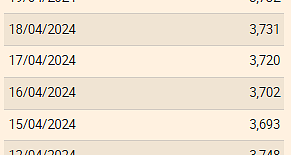The quota acts - but only where it applies. So, to summarise what has happened in this country in the past year in terms of women in leadership positions. In the 100 biggest German companies by turnover, the share of women has increased in the Supervisory boards of a good three percentage points to 28.4 per cent; in the 200 largest companies, there were points in just under 27 percent and an increase of 2.3 percent. The managers Barometer is regularly collected by the German Institute for economic research (DIW). On Wednesday it was presented in Berlin.
The financial industry has seen the DIW separately: The proportion of women in the boards of the 100 largest banks in Germany stagnated in 2018 at just under nine percent. In the 60 largest insurance companies increased by a percentage point to almost ten percent. The proportion of women in the Supervisory bodies in the year 2018 at around 23 percent.
Since 2016 to have listed on the stock exchange and on a basis of parity co-determined companies, where employers and employees are equally represented in the Supervisory bodies, at least 30 percent women on their Supervisory boards sit. That the in in the a total of 104 companies that were the end of 2018 under this quota. There, the proportion of women in the Supervisory boards at the end of the year with just under 33 per cent, almost three percentage points higher than in the previous year. The Dax-30-companies were also on the proportion of women is a third. However, they had achieved this share in the previous year. The DIW researchers Elke Holst and Catherine pull Wrohlich to the fact that nothing has changed, the conclusion that "apparently, many companies in their efforts to win women for the Supervisory bodies to Reach the legally required percentage of Women in Supervisory boards back to, or even the whole set".
in Addition, the latest Figures to be another, more sobering realization: The women's quota for Supervisory boards seems to have no special impact on the members of the management Board. There is no quota; the hope was that more women on corporate boards would result in women the rise in the members of the Board easier. The DIW report States that studies have shown that there is in Norway or Australia evidence of such "Spillover"effects. In Germany this has not happened yet. At least in the short term should not be assumed that "a higher proportion of women in Supervisory boards to be automatically leads to a higher proportion of women in boards of Directors", - stated in the study. This could, however, give those a boost, the demand for the members of the management Board of company a women's quota.
In the boards of companies that fall under the Supervisory ratio, also sat last year, only 8.5 percent of women. And: It went ahead, because compared with the 7.9 percent of the previous year, was only a minimal improvement. Overall, a woman on the Board, sits only every third of these companies at all - and the chair has only two companies, a woman.
In the group of the largest 100 companies, the proportion of women has, however, reached in the boards for the first time, the Ten-percent mark. However, almost 60 percent of the members of the management Board are also there for a woman. And the growth was also in this group, with almost one and a half percentage points in just rapidly.
it is Interesting to note another aspect: The policy itself is not moving forward is really a good example, as regards women in top positions. Also in the 60 portfolio companies in the Federal government, a woman on the Board, and the share of women on Executive boards decreased in the past year, even sitting in each of the third party; by around four percentage points to 14 percent. This was "a turning point", write the DIW researchers. Previously, the proportion of women from 2010 to 2017 had risen continuously from almost seven to almost 18 percent.

 The Euribor today remains at 3.734%
The Euribor today remains at 3.734% Germany: the trial of an AfD leader, accused of chanting a Nazi slogan, resumes this Tuesday
Germany: the trial of an AfD leader, accused of chanting a Nazi slogan, resumes this Tuesday New York: at Columbia University, the anti-Semitic drift of pro-Palestinian demonstrations
New York: at Columbia University, the anti-Semitic drift of pro-Palestinian demonstrations What is Akila, the mission in which the Charles de Gaulle is participating under NATO command?
What is Akila, the mission in which the Charles de Gaulle is participating under NATO command? What High Blood Pressure Does to Your Body (And Why It Should Be Treated)
What High Blood Pressure Does to Your Body (And Why It Should Be Treated) Vaccination in France has progressed in 2023, rejoices Public Health France
Vaccination in France has progressed in 2023, rejoices Public Health France Food additives suspected of promoting cardiovascular diseases
Food additives suspected of promoting cardiovascular diseases “Even morphine doesn’t work”: Léane, 17, victim of the adverse effects of an antibiotic
“Even morphine doesn’t work”: Léane, 17, victim of the adverse effects of an antibiotic MEPs validate reform of EU budgetary rules
MEPs validate reform of EU budgetary rules “Public Transport Paris 2024”, the application for Olympic Games spectators, is available
“Public Transport Paris 2024”, the application for Olympic Games spectators, is available Spotify goes green in the first quarter and sees its number of paying subscribers increase
Spotify goes green in the first quarter and sees its number of paying subscribers increase Xavier Niel finalizes the sale of his shares in the Le Monde group to an independent fund
Xavier Niel finalizes the sale of his shares in the Le Monde group to an independent fund Owner of Blondie and Shakira catalogs in favor of $1.5 billion offer
Owner of Blondie and Shakira catalogs in favor of $1.5 billion offer Cher et Ozzy Osbourne rejoignent le Rock and Roll Hall of Fame
Cher et Ozzy Osbourne rejoignent le Rock and Roll Hall of Fame Three months before the Olympic Games, festivals and concert halls fear paying the price
Three months before the Olympic Games, festivals and concert halls fear paying the price With Brigitte Macron, Aya Nakamura sows new clues about her participation in the Olympics
With Brigitte Macron, Aya Nakamura sows new clues about her participation in the Olympics Skoda Kodiaq 2024: a 'beast' plug-in hybrid SUV
Skoda Kodiaq 2024: a 'beast' plug-in hybrid SUV Tesla launches a new Model Y with 600 km of autonomy at a "more accessible price"
Tesla launches a new Model Y with 600 km of autonomy at a "more accessible price" The 10 best-selling cars in March 2024 in Spain: sales fall due to Easter
The 10 best-selling cars in March 2024 in Spain: sales fall due to Easter A private jet company buys more than 100 flying cars
A private jet company buys more than 100 flying cars This is how housing prices have changed in Spain in the last decade
This is how housing prices have changed in Spain in the last decade The home mortgage firm drops 10% in January and interest soars to 3.46%
The home mortgage firm drops 10% in January and interest soars to 3.46% The jewel of the Rocío de Nagüeles urbanization: a dream villa in Marbella
The jewel of the Rocío de Nagüeles urbanization: a dream villa in Marbella Rental prices grow by 7.3% in February: where does it go up and where does it go down?
Rental prices grow by 7.3% in February: where does it go up and where does it go down? Europeans: “All those who claim that we don’t need Europe are liars”, criticizes Bayrou
Europeans: “All those who claim that we don’t need Europe are liars”, criticizes Bayrou With the promise of a “real burst of authority”, Gabriel Attal provokes the ire of the opposition
With the promise of a “real burst of authority”, Gabriel Attal provokes the ire of the opposition Europeans: the schedule of debates to follow between now and June 9
Europeans: the schedule of debates to follow between now and June 9 Europeans: “In France, there is a left and there is a right,” assures Bellamy
Europeans: “In France, there is a left and there is a right,” assures Bellamy These French cities that will boycott the World Cup in Qatar
These French cities that will boycott the World Cup in Qatar Serie A: Bologna surprises AS Rome in the race for the C1
Serie A: Bologna surprises AS Rome in the race for the C1 Serie A: Marcus Thuram king of Italy, end of the debate for the position of number 9 with the Blues?
Serie A: Marcus Thuram king of Italy, end of the debate for the position of number 9 with the Blues? Milan AC-Inter Milan: Thuram and Pavard impeccable, Hernandez helpless… The tops and flops of the derby
Milan AC-Inter Milan: Thuram and Pavard impeccable, Hernandez helpless… The tops and flops of the derby Ligue 2: Auxerre leader, Bordeaux in crisis, play-offs... 5 questions about an exciting end of the season
Ligue 2: Auxerre leader, Bordeaux in crisis, play-offs... 5 questions about an exciting end of the season


















